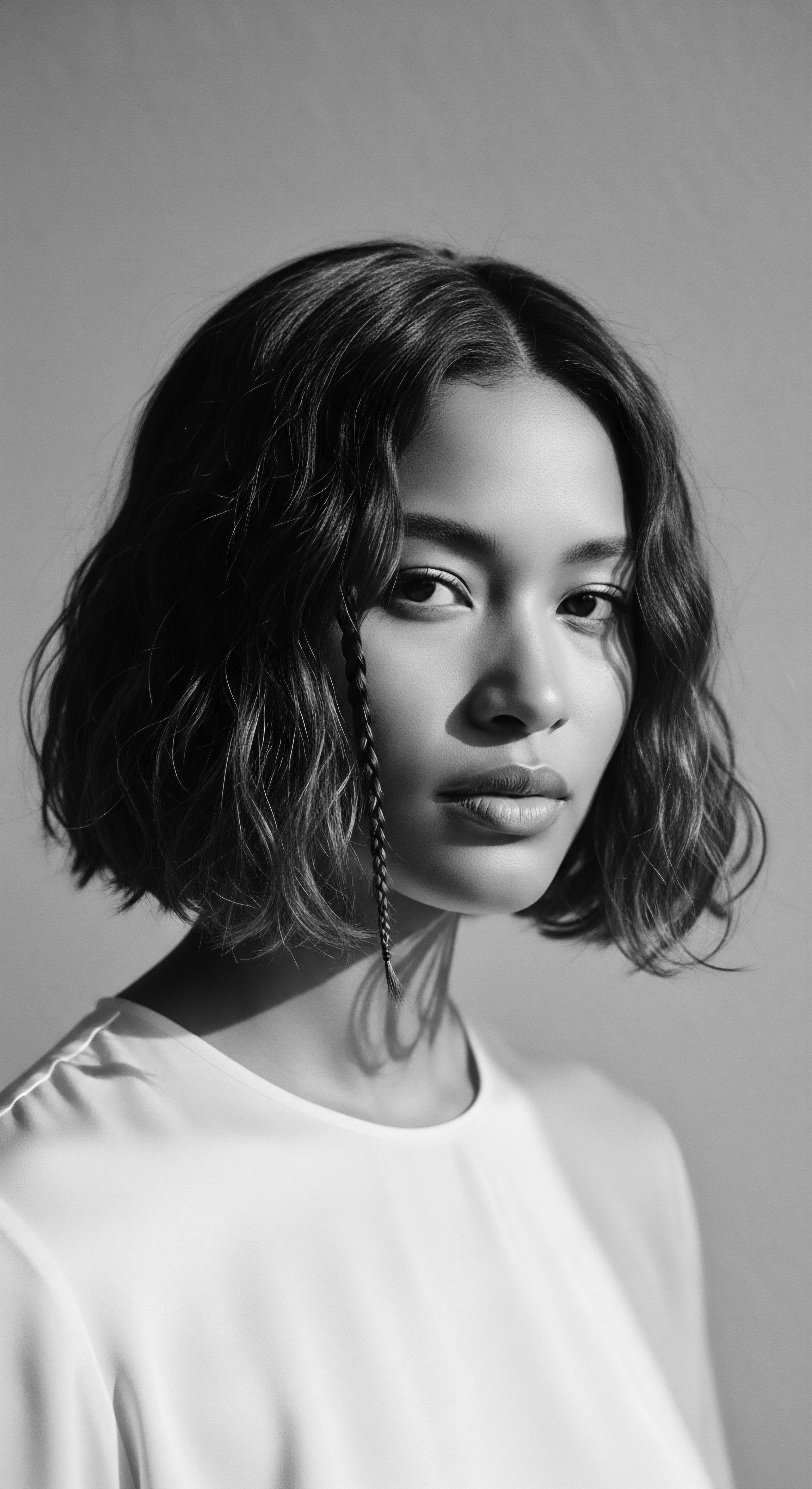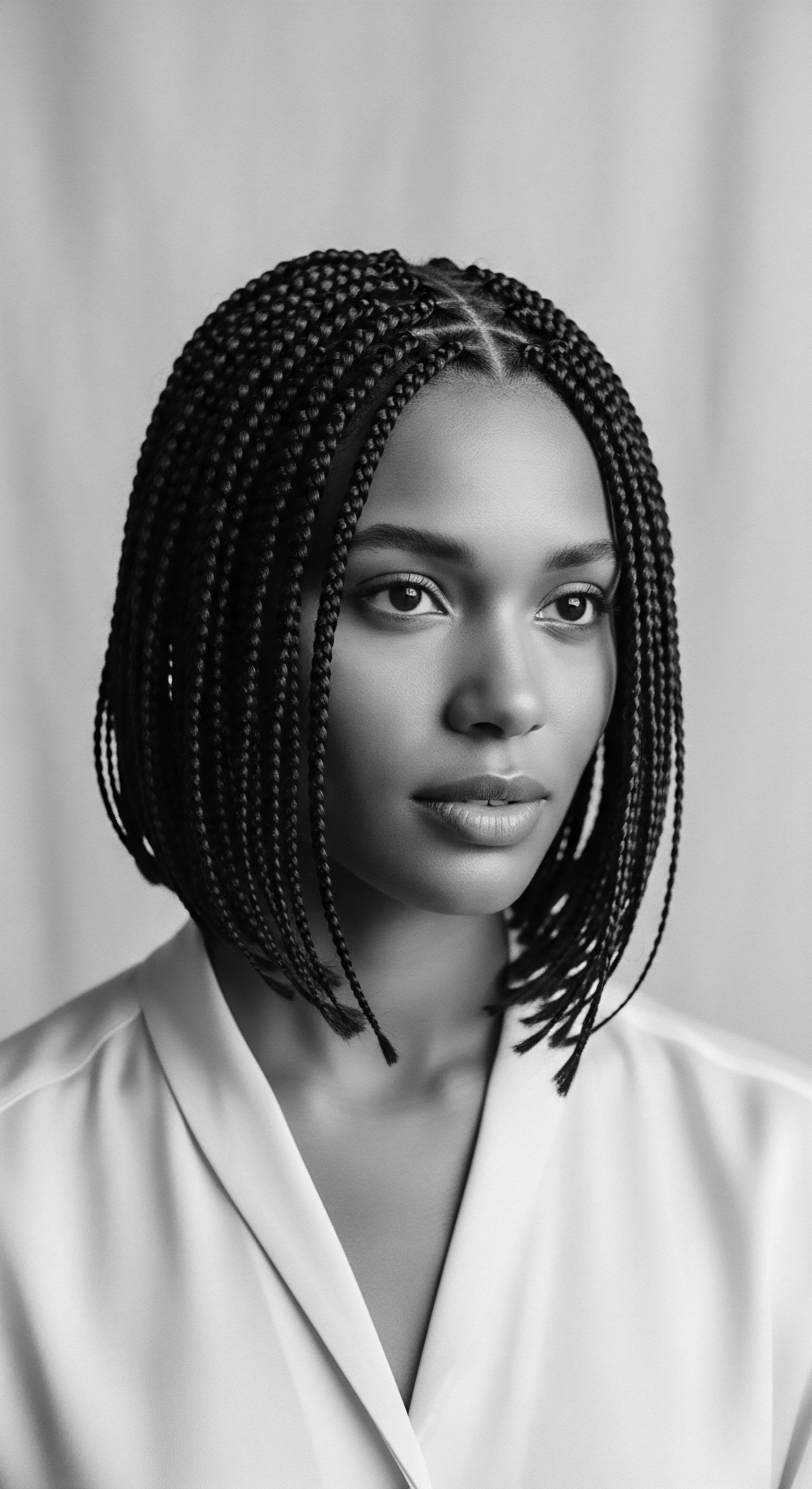
Fundamentals
The concept of Calabash Hair Care, at its heart, represents a profound connection between the elemental world of the plant kingdom and the intricate artistry of human hair traditions. It is an explanation of care practices deeply rooted in ancestral wisdom, where the calabash gourd , a dried fruit of the Lagenaria siceraria plant, transcends its simple botanical origin to become a vessel of profound cultural and spiritual significance for textured hair. This approach recognizes hair not merely as a biological structure, but as a living archive of heritage, identity, and communal memory.
From a foundational perspective, Calabash Hair Care signifies an approach to hair tending that values the wisdom passed through generations. It emphasizes the use of natural ingredients, often sourced from local environments, and the employment of hand-crafted tools and communal rituals. The calabash itself, in its varied forms—from a humble container for oils and concoctions to a finely carved adornment—serves as a tangible link to these time-honored methods. It is an interpretation of care that prioritizes the health and integrity of textured hair, recognizing its unique needs and celebrating its inherent beauty, a concept often overlooked or even disparaged by Eurocentric beauty standards.
Calabash Hair Care embodies a heritage-rich approach to textured hair, utilizing natural gourds and ancestral wisdom as cornerstones of well-being and identity.
Understanding Calabash Hair Care involves appreciating how historical ingenuity shaped methods for cleansing, nourishing, and styling hair. These methods, often developed through close observation of nature, provided effective solutions for maintaining hair vitality long before the advent of modern cosmetic chemistry. It is a delineation of practices that are both practical and symbolic, where the act of caring for hair becomes a meditative ritual, strengthening bonds to lineage and land.

The Calabash as a Primary Implement
The calabash, a versatile gourd, finds diverse applications within traditional communities, ranging from domestic utility to ceremonial importance. It is used as a vessel for water and food, shaped into musical instruments, and fashioned into decorative items. In the context of hair care, it traditionally served as a receptacle for carefully prepared hair treatments, infusions, and natural oils like shea butter or palm oil, which historically moisturized and dressed the hair. The selection of a particular calabash for hair care might have been based on its size, shape, or even specific spiritual attributes, reflecting the deep reverence accorded to natural elements within these ancestral traditions.
- Storage Vessels ❉ Calabashes, particularly dried bottle gourds, provided airtight and natural containers for storing precious hair oils, herbal infusions, and other concoctions. This preservation method allowed for extended use of prepared remedies.
- Application Tools ❉ Smaller calabash scoops or halved gourds served as direct application tools, facilitating the gentle distribution of treatments across the scalp and hair strands, ensuring an even and measured application.
- Cleansing Bowls ❉ Larger calabash bowls were used during communal hair washing rituals, holding water, natural cleansers like black soap, or herbal rinses. These bowls created a sacred space for the shared experience of hair tending.

Intermediate
Stepping into a deeper comprehension of Calabash Hair Care reveals its significance beyond rudimentary practices, positioning it as a holistic framework for textured hair well-being. This perspective recognizes that the practice extends beyond the mere application of products; it encompasses a philosophy of care that honors the innate characteristics of kinky, coily, and wavy hair patterns while acknowledging their distinct historical journeys. It is a broader interpretation that weaves together biological reality with cultural narratives, offering a sense of rootedness for individuals navigating the complexities of their hair heritage.
The meaning of Calabash Hair Care at this level pertains to the sustained legacy of resourcefulness and ancestral ingenuity. In many African societies, hair carried substantial social weight, indicating aspects of identity such as age, social status, and tribal affiliation. Hair care rituals often were communal activities, fostering social bonds and strengthening familial ties.
The use of the calabash within these communal settings transforms a simple tool into a symbol of collective wisdom and shared experience. It underscores the profound link between personal grooming, community cohesion, and the preservation of identity amidst historical challenges.
Calabash Hair Care symbolizes the enduring ingenuity of ancestral communities, transforming functional gourds into cultural artifacts that bind people through shared hair rituals and identity.
An understanding of Calabash Hair Care means acknowledging the deliberate choices made by ancestors to nourish and protect their hair with what nature provided. Traditional ingredients like shea butter, palm oil, coconut oil, aloe vera, and various herbal extracts formed the bedrock of these regimens. These natural elements were not randomly chosen; rather, their properties were meticulously observed and understood over generations. This accumulated knowledge, often transmitted orally, formed a sophisticated ethnobotanical science focused on hair health.

Traditional Hair Preparations and Their Vessels
The preparation of traditional hair treatments often involved specific botanical ingredients, each chosen for its purported benefits to the scalp and hair. The calabash, as a natural container, played a key role in these preparations, sometimes even contributing to the efficacy of the remedies through its porous, breathable nature. This symbiotic relationship between plant and vessel highlights the deep ecological awareness embedded in ancestral hair care.
Consideration of the calabash in this context also means recognizing its role in rituals that went beyond simple beautification. In some traditions, calabashes held water believed to bring fertility, or powdered medicines for various ailments, signifying a broader connection to spiritual well-being. The transfer of these practices through generations, even in the face of immense adversity, speaks volumes about their inherent value.
| Purpose Cleansing Hair |
| Traditional Application (Calabash Role) Used as a basin for natural cleansers like black soap diluted with water, often during communal washing. |
| Cultural Significance Promoted communal bonding, symbolized purity and fresh starts, particularly for young women. |
| Purpose Conditioning Hair |
| Traditional Application (Calabash Role) Served as storage for oils (e.g. shea butter, palm oil) and herbal infusions applied to hair. |
| Cultural Significance Represented nourishment and protection, honoring the hair's sacred connection to identity. |
| Purpose Styling & Adornment |
| Traditional Application (Calabash Role) Used for holding styling aids, or carved fragments integrated into hairstyles for symbolic meaning. |
| Cultural Significance Marked social status, age, or tribal affiliation; acted as a silent language of heritage and belonging. |
| Purpose Ritualistic Care |
| Traditional Application (Calabash Role) Contained ceremonial liquids or powdered herbal remedies for spiritual cleansing or fertility rites. |
| Cultural Significance Connected hair care to broader cosmological beliefs, intertwining physical well-being with spiritual harmony. |
| Purpose These traditional applications of the calabash within hair care underscore its role as a vessel of both practical utility and profound cultural heritage across diverse African communities. |

Academic
The academic understanding of Calabash Hair Care posits it as a complex cultural construct, a system of knowledge and practice that transcends its material components to embody an enduring epistemology of textured hair within Black and mixed-race experiences. It is an elucidation that demands rigorous inquiry into its origins, its adaptations through historical periods, and its contemporary resonance as a symbol of identity and resistance. This definition probes the layers of ancestral wisdom, often validated by modern scientific observations, and examines how hair care, through the lens of the calabash, functions as a site of self-determination and cultural reaffirmation.
At this advanced level, Calabash Hair Care is an intricate specification of traditional phytocosmetology and ethnosociology, where the gourd (Lagenaria siceraria) acts as a metonym for an entire relational paradigm between human beings, their environment, and their corporeal expressions of heritage. The practices associated with the calabash—from its cultivation and carving to its ceremonial use—are not mere folk remedies; they are sophisticated systems of sustained well-being. These practices were developed and refined over centuries, relying on empirical observation and intergenerational transmission of knowledge, deeply embedded within the fabric of community life.

Echoes from the Source ❉ The Biological and Anthropological Grounding
The biological properties of textured hair, with its unique follicular structure and susceptibility to moisture loss, necessitated specific care regimens. Ancestral communities, lacking contemporary scientific instruments, intuitively developed methods that addressed these needs. This pre-scientific understanding of hair biology, often framed within a spiritual or holistic worldview, found expression in practices like regular oiling with natural emollients and protective styling, often facilitated by tools and containers like the calabash. For instance, ethnobotanical studies across Africa reveal a consistent reliance on plants like Ziziphus spina-christi and Sesamum orientale for hair cleansing and conditioning, with these preparations often mixed and stored in traditional vessels such as the calabash (Amoakowaa Bekoe et al.
2021). This historical reliance speaks to an empirical wisdom, where efficacy was proven through generations of lived experience and observation.
Anthropologically, the calabash is a vessel of symbolic communication. In some Ghanaian traditions, the calabash embodies wisdom and the cycle of existence, reflecting balance and adaptability. Its division into symmetrical halves, representing masculine and feminine principles, or visible and invisible realms in Kedjom tradition, suggests a cosmological framework within which hair care was situated. When a calabash held a hair preparation, it imbued the act of grooming with these layers of meaning, transforming routine maintenance into a sacred ritual.
This profound cultural meaning contrasts sharply with the dehumanization experienced during the transatlantic slave trade, where the forcible shaving of enslaved Africans’ heads aimed to strip them of identity and sever ties to their heritage. In such contexts, any effort to reclaim or maintain traditional hair practices, including the use of customary tools and ingredients, became an act of profound resistance and an assertion of self.
Calabash Hair Care represents a resilient legacy of self-determination, defying historical attempts to erase Black identity by upholding ancestral hair practices and honoring natural textured hair.

The Tender Thread ❉ Living Traditions of Care and Community
The application of Calabash Hair Care throughout history often occurred within intimate familial or communal settings. Braiding hair, for example, was and remains a communal activity in many African cultures, strengthening bonds between mothers, daughters, and friends while preserving cultural identity. The calabash, as a container for oils and tools during these sessions, was more than an inert object; it was a participant in the shared experience, bearing witness to conversations, stories, and the transfer of intergenerational knowledge.
This shared experience underscores the sociological significance of hair care as a mechanism for social cohesion and cultural transmission. The collective care inherent in these traditions fostered a deep sense of belonging and reinforced ancestral values, acting as a bulwark against external pressures to conform to Eurocentric beauty standards.
The contemporary resurgence of natural hair movements within the diaspora reflects a continuation of this ancestral spirit, albeit in a modernized context. These movements, gaining significant momentum in the early 2000s, directly challenge the historical imposition of Eurocentric beauty norms which often pathologized textured hair. The conscious choice to embrace one’s natural coils and kinks, to seek out ingredients and practices that honor ancestral wisdom, is a powerful act of decolonization. Many contemporary hair wellness advocates draw direct inspiration from these older ways of knowing, validating the efficacy of natural ingredients and traditional techniques through modern scientific understanding, bridging the perceived divide between ancient wisdom and contemporary research.
- Oral Transmission of Knowledge ❉ Recipes for hair treatments and styling techniques were passed down verbally, often during the communal act of grooming. This ensured the preservation of indigenous knowledge systems related to hair care.
- Holistic Well-Being ❉ Calabash Hair Care was seldom isolated from overall well-being. The connection of hair to spirituality, community, and health meant that care rituals addressed not only physical strands but also mental and spiritual states.
- Adaptive Resilience ❉ Despite displacement and the imposition of oppressive beauty standards, communities in the diaspora adapted ancestral practices, using available resources to maintain connections to their hair heritage. This adaptation demonstrates a profound resilience.

The Unbound Helix ❉ Voicing Identity and Shaping Futures
The continuous relevance of Calabash Hair Care in the modern era lies in its profound political and personal implications. For many, choosing to engage with practices rooted in ancestral wisdom represents a conscious rejection of historical marginalization and an affirmation of self-worth. The ‘Black is Beautiful’ movement of the 1960s and subsequent natural hair movements were instrumental in redefining beauty norms, celebrating the intrinsic beauty of textured hair and dismantling the ‘good hair’ versus ‘bad hair’ hierarchy perpetuated by colonial influences. This shift was not merely aesthetic; it was a socio-political statement, a declaration of cultural pride and self-acceptance.
Calabash Hair Care, in its purest meaning, is a living, breathing testament to the ingenuity and fortitude of those who maintained their cultural markers even under extreme oppression. The act of maintaining traditional hair practices, often with makeshift tools and hidden knowledge, transformed hair into an invaluable source of connection to homeland and a potent reminder of self-worth. It became a channel for preserving cultural memory, a quiet act of defiance against efforts to erase identity.
The “Magical Calabash” concept, referring to a traditional magic pot representing the cosmic womb into which ingredients are added to manifest intentions, underscores the deep spiritual dimension woven into this heritage of care (Kumari, 2014). This spiritual significance means that caring for textured hair through ancestral methods is not merely about aesthetic results; it is about tuning one’s frequency, clearing energetic debris, and strengthening spiritual protection, connecting individuals to ancestral wisdom and their higher selves.
| Aspect of Care Primary Tools |
| Ancestral Practices (Pre-Colonial/Diaspora Origins) Calabashes, natural combs (e.g. made from wood or bone), hands, fingers. |
| Modern Adaptation (Post-Natural Hair Movement) Specialized wide-tooth combs, detangling brushes, silicone-free applicators, and contemporary calabash-inspired vessels. |
| Aspect of Care Key Ingredients |
| Ancestral Practices (Pre-Colonial/Diaspora Origins) Locally sourced plant oils (shea butter, palm oil), herbal infusions, natural clays, black soap. |
| Modern Adaptation (Post-Natural Hair Movement) Scientifically formulated blends of natural oils and butters, plant extracts, protein treatments, sulfate-free cleansers. |
| Aspect of Care Philosophy of Care |
| Ancestral Practices (Pre-Colonial/Diaspora Origins) Holistic health, communal ritual, spiritual connection, expression of social status/identity. |
| Modern Adaptation (Post-Natural Hair Movement) Self-love, self-acceptance, decolonization of beauty standards, scientific validation of natural ingredients, community through digital platforms. |
| Aspect of Care Preservation of Knowledge |
| Ancestral Practices (Pre-Colonial/Diaspora Origins) Oral tradition, apprenticeship within families and communities, direct observation. |
| Modern Adaptation (Post-Natural Hair Movement) Online tutorials, natural hair communities, ethnobotanical research, product labeling, educational workshops. |
| Aspect of Care The journey of textured hair care demonstrates a remarkable continuity, where ancestral practices provide the enduring blueprint for modern adaptations, consistently emphasizing the intrinsic value of natural hair. |
The meaning of Calabash Hair Care is therefore a dynamic one, reflecting an ongoing dialogue between historical memory and contemporary agency. It is a powerful designation for the enduring resilience of textured hair heritage, standing as a living testament to cultural continuity and the vibrant, ever-evolving expressions of Black and mixed-race identity across the globe. This interpretation acknowledges that while the tools and contexts may shift, the deep respect for hair as a source of cultural knowledge and personal power remains.

Reflection on the Heritage of Calabash Hair Care
To contemplate Calabash Hair Care is to peer into the Soul of a Strand, recognizing that each curl, coil, and wave carries the whispers of generations past. It is an invitation to witness the profound journey of textured hair, from the ancient hearths of Africa, where calabashes served as sacred vessels for nurturing elixirs, through the arduous passages of forced migration, and into the vibrant tapestry of contemporary identities. The enduring essence of this practice lies not solely in the physical implements or the botanical ingredients, but in the spirit of reverence it cultivates—a deep, abiding respect for what has been, what is, and what can be.
The calabash, often humble in its material form, stands as a powerful symbol of continuous resilience. It speaks to a wisdom that understood the earth’s bounty as a source of sustenance not only for the body but for the very spirit. The legacy of hands gently applying oils, fingers deftly forming intricate patterns, and voices sharing stories during communal grooming sessions, represents a heritage of care that transcended hardship. This rich inheritance continues to inspire a re-connection to the authentic self, reminding us that hair care is a sacred dialogue with our lineage, a moment to honor the ancestral energies that flow through our strands.
The evolving significance of Calabash Hair Care in a world increasingly conscious of its diverse beauty standards offers a path forward. It prompts us to consider how traditional ecological knowledge, often preserved in practices such as these, holds keys to sustainable and ethical approaches to beauty. By understanding and celebrating the deep historical roots of textured hair care, we contribute to a global conversation that values authenticity, promotes self-acceptance, and fosters a renewed appreciation for the ingenious ways our forebears navigated their worlds, leaving behind a legacy of beauty that is both deeply personal and universally resonant. The Soul of a Strand truly does carry the memory of a calabash, a touchstone to our shared human story.

References
- Amoakowaa Bekoe, A. Frimpong, C. K. & Asinyo, G. (2021). Conceptual Fabric-Calabash Art Installation. Journal of Urban Culture Research, 23, 149-166.
- Byrd, A. D. & Tharps, L. D. (2014). Hair Story ❉ Untangling the Roots of Black Hair in America. St. Martin’s Press.
- Knöpfli, H. (2001). Hair ❉ The Social History of Hair in Africa. Otto Harrassowitz Verlag.
- Kumari, A. (2014). Magical Calabash ❉ Sacred Wisdom and Healing of African Ancestral Mothers. CreateSpace Independent Publishing Platform.
- Patton, T. (2006). Pushing it ❉ Cultural Politics of Black Women’s Hair. Rutgers University Press.
- Rice, L. (2017). Hair Story ❉ The Definitive Guide to Black and African-American Hair. St. Martin’s Griffin.
- Stephanou, R. (2020). The Calabash ❉ A Universal Symbol. Africa World Press.
